tyre pressure Citroen DS4 2011 1.G Owner's Manual
[x] Cancel search | Manufacturer: CITROEN, Model Year: 2011, Model line: DS4, Model: Citroen DS4 2011 1.GPages: 396, PDF Size: 31.05 MB
Page 11 of 396
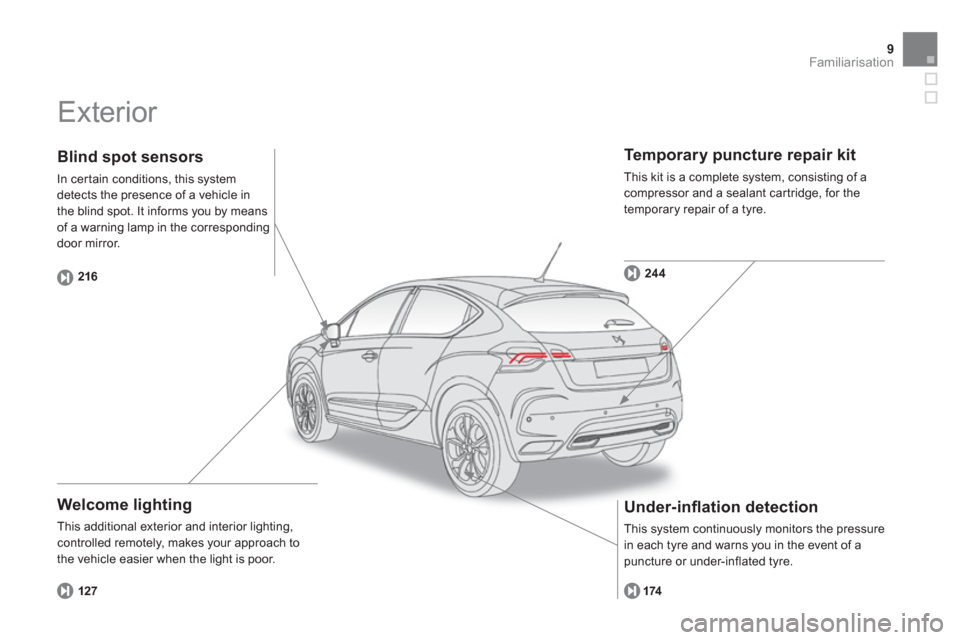
9Familiarisation
Exterior
Welcome lighting
This additional exterior and interior lighting,
controlled remotely, makes your approach to
the vehicle easier when the light is poor.
Temporary puncture repair kit
This kit is a complete system, consisting of a
compressor and a sealant car tridge, for the
temporary repair of a tyre.
127
244
Under-infl ation detection
This system continuously monitors the pressure
in each tyre and warns you in the event of a
puncture or under-inflated tyre.
174
Blind spot sensors
In cer tain conditions, this system
detects the presence of a vehicle in
the blind spot. It informs you by means
of a warning lamp in the corresponding
door mirror.
216
Page 37 of 396
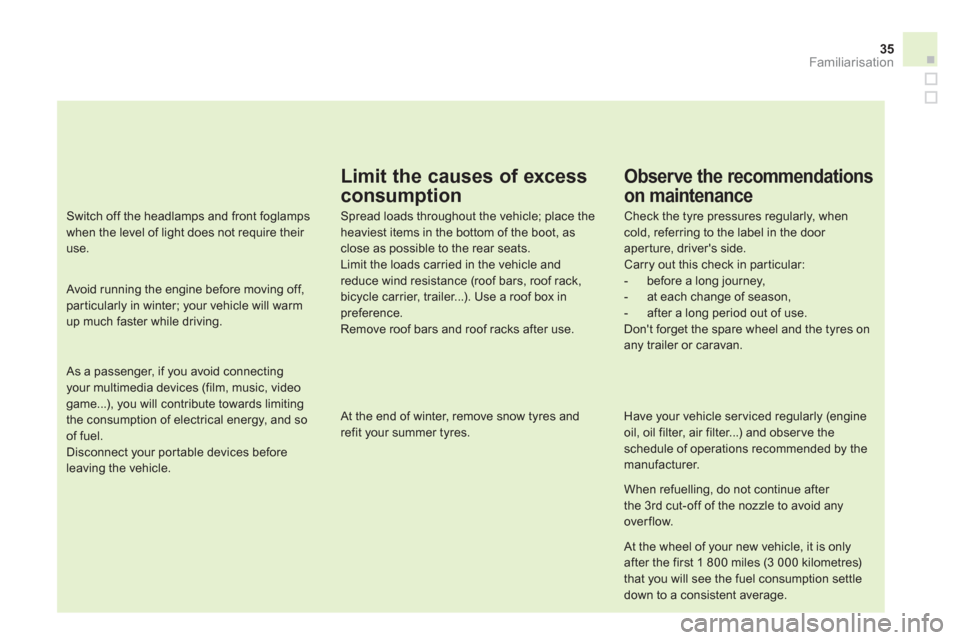
35
Limit the causes of excess
consumption
Spread loads throughout the vehicle; place the
heaviest items in the bottom of the boot, as
close as possible to the rear seats.
Limit the loads carried in the vehicle and
reduce wind resistance (roof bars, roof rack,
bicycle carrier, trailer...). Use a roof box in
preference.
Remove roof bars and roof racks after use.
At the end of winter, remove snow tyres and
refit your summer tyres.
Observe the recommendations
on maintenance
Check the tyre pressures regularly, when
cold, referring to the label in the door
aperture, driver's side.
Carry out this check in par ticular:
- before a long journey,
- at each change of season,
- after a long period out of use.
Don't forget the spare wheel and the tyres on
any trailer or caravan.
Have your vehicle ser viced regularly (engine
oil, oil filter, air filter...) and obser ve the
schedule of operations recommended by the
manufacturer.
When refuelling, do not continue after
the 3 rd cut-off of the nozzle to avoid any
over flow.
At the wheel of your new vehicle, it is only
after the first 1 800 miles (3 000 kilometres)
that you will see the fuel consumption settle
down to a consistent average.
Switch off the headlamps and front foglamps
when the level of light does not require their
use.
Avoid running the engine before moving off,
particularly in winter; your vehicle will warm
up much faster while driving.
As a passenger, if you avoid connecting
your multimedia devices (film, music, video
game...), you will contribute towards limiting
the consumption of electrical energy, and so
of fuel.
Disconnect your portable devices before
leaving the vehicle.
Familiarisation
Page 44 of 396
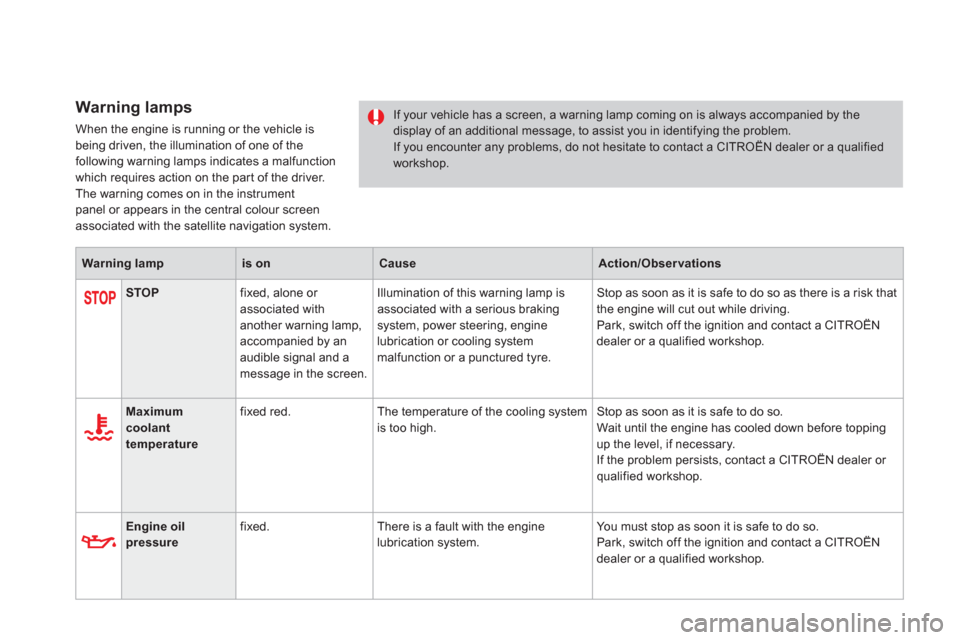
Warning lamps
When the engine is running or the vehicle is
being driven, the illumination of one of the
following warning lamps indicates a malfunction
which requires action on the par t of the driver.
The warning comes on in the instrument
panel or appears in the central colour screen
associated with the satellite navigation system. If your vehicle has a screen, a warning lamp coming on is always accompanied by the
display of an additional message, to assist you in identifying the problem.
If you encounter any problems, do not hesitate to contact a CITROËN dealer or a qualified
workshop.
Warning lamp
is on
Cause
Action/Observations
STOP
fixed, alone or
associated with
another warning lamp,
accompanied by an
audible signal and a
message in the screen. Illumination of this warning lamp is
associated with a serious braking
system, power steering, engine
lubrication or cooling system
malfunction or a punctured tyre. Stop as soon as it is safe to do so as there is a risk that
the engine will cut out while driving.
Park, switch off the ignition and contact a CITROËN
dealer or a qualified workshop.
Maximum
coolant
temperature
fixed red. The temperature of the cooling system
is too high. Stop as soon as it is safe to do so.
Wait until the engine has cooled down before topping
up the level, if necessary.
If the problem persists, contact a CITROËN dealer or
qualified workshop.
Engine oil
pressure
fixed. There is a fault with the engine
lubrication system. You must stop as soon it is safe to do so.
Park, switch off the ignition and contact a CITROËN
dealer or a qualified workshop.
Page 47 of 396
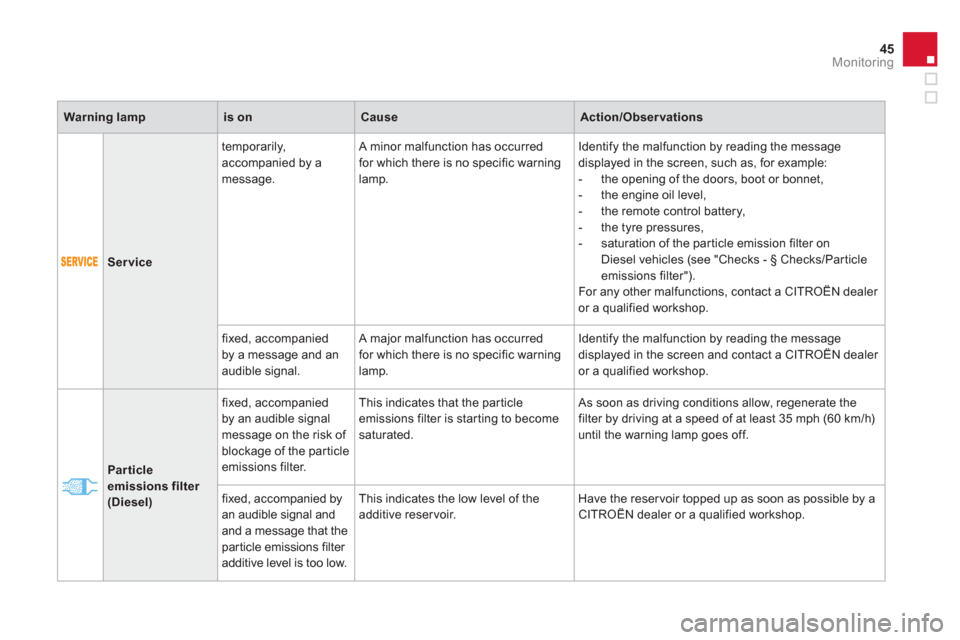
45Monitoring
Service
temporarily,
accompanied by a
message. A minor malfunction has occurred
for which there is no specific warning
lamp. Identify the malfunction by reading the message
displayed in the screen, such as, for example:
- the opening of the doors, boot or bonnet,
- the engine oil level,
- the remote control battery,
- the tyre pressures,
- saturation of the par ticle emission filter on
Diesel vehicles (see "Checks - § Checks/Particle
emissions filter").
For any other malfunctions, contact a CITROËN dealer
or a qualified workshop.
fixed, accompanied
by a message and an
audible signal. A major malfunction has occurred
for which there is no specific warning
lamp. Identify the malfunction by reading the message
displayed in the screen and contact a CITROËN dealer
or a qualified workshop.
Warning lamp
is on
Cause
Action/Observations
Particle
emissions filter
(Diesel)
fixed, accompanied
by an audible signal
message on the risk of
blockage of the particle
emissions filter. This indicates that the par ticle
emissions filter is star ting to become
saturated. As soon as driving conditions allow, regenerate the
filter by driving at a speed of at least 35 mph (60 km/h)
until the warning lamp goes off.
fixed, accompanied by
an audible signal and
and a message that the
particle emissions filter
additive level is too low.
This indicates the low level of the
additive reservoir. Have the reser voir topped up as soon as possible by a
CITROËN dealer or a qualified workshop.
Page 49 of 396

47Monitoring
Power steering
fixed. The power steering has a fault. Drive carefully at reduced speed.
Have it checked by a CITROËN dealer or a qualified
workshop.
Under-inflated
tyre
fixed. The pressure in one or more wheels
is too low. Check the pressure of the tyres as soon as possible.
This check should preferably be carried out when
the tyres are cold.
Directional
headlamps
flashing. The directional headlamps system
has a fault. Have it checked by a CITROËN dealer or a qualified
workshop.
Warning lamp
is on
Cause
Action/Observations
Foot on the brake
pedal
fixed. The brake pedal is not pressed. With the 6 -speed electronic gearbox system, press
the brake pedal to star t the engine (lever in position N
).
If you wish to release the parking brake without
pressing the brake pedal, this warning lamp will
remain on.
flashing. With the 6 -speed electronic gearbox
system, if you hold the vehicle on an
incline using the accelerator for too
long, the clutch overheats. Use the brake pedal and/or the electric parking brake.
Airbags
temporarily. This lamp comes on for a few
seconds when you turn on the
ignition, then goes off. This lamp should go off when the engine is star ted.
If it does not go off, contact a CITROËN dealer or a
qualified workshop.
fixed. One of the airbag or seat belt
pretensioner systems has a fault. Have it checked by a CITROËN dealer or a qualified
workshop.
Page 176 of 396
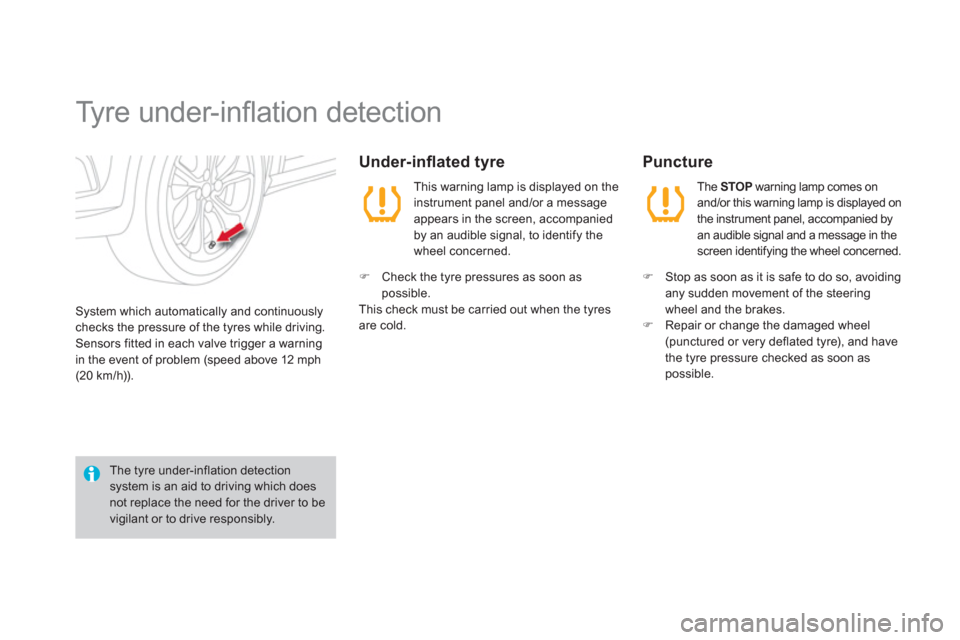
Ty r e u n d e r - i nfl ation detection
System which automatically and continuously
checks the pressure of the tyres while driving.
Sensors fitted in each valve trigger a warning
in the event of problem (speed above 12 mph
(20 km/h)).
Puncture
The tyre under-inflation detection
system is an aid to driving which does
not replace the need for the driver to be
vigilant or to drive responsibly.
Under-infl ated tyre
This warning lamp is displayed on the
instrument panel and/or a message
appears in the screen, accompanied
by an audible signal, to identify the
wheel concerned. The STOP
warning lamp comes on
and/or this warning lamp is displayed on
the instrument panel, accompanied by
an audible signal and a message in the
screen identifying the wheel concerned.
�)
Stop as soon as it is safe to do so, avoiding
any sudden movement of the steering
wheel and the brakes.
�)
Repair or change the damaged wheel
(punctured or very deflated tyre), and have
the tyre pressure checked as soon as
possible.
�)
Check the tyre pressures as soon as
possible.
This check must be carried out when the tyres
are cold.
Page 177 of 396

175
Safety
Sensor(s) not detected or faulty
A message appears in the screen,
accompanied by an audible signal, to identify
the wheel or wheels which are not detected or
to indicate a malfunction in the system.
Contact a CITROËN dealer or a qualified
workshop to replace the faulty sensor(s). All repairs and changing of tyres on a
wheel fitted with this system must be
carried out by a CITROËN dealer or a
qualified workshop.
If, when changing a tyre, you install a
wheel which is not detected by your
vehicle (example: fitting of snow tyres),
you must have the system reinitialised
by a CITROËN dealer or a qualified
workshop. This system does not avoid the need
to have the tyre pressures checked
regularly (refer to the "Identification
markings" section) to ensure that
the optimum dynamic per formance
of the vehicle is maintained and
prevent premature wear of the
tyres, par ticularly in arduous driving
conditions (heavy load, high speed).
The tyre pressures must be checked
cold, at least once a month. Remember
to check the pressure of the spare
wheel.
The tyre under-inflation detection
system may experience temporary
inter ference due to electro-magnetic
emissions on a frequency close to that
used by the system.
This message is also displayed when
one of the wheels is away from the
vehicle (being repaired) or when one
or more wheels without a sensor are
fitted.
If your vehicle is equipped with a spare
wheel, this is not fitted with a sensor.
Page 178 of 396

Braking assistance systems
Group of supplementary systems which help
you to obtain optimum braking in complete
safety in emergency situations:
- anti-lock braking system (ABS),
- electronic brake force distribution (EBFD),
- emergency braking assistance (EBA).
Anti-lock braking system
and electronic brake force
distribution
Linked systems which improve the stability and
manoeuvrability of your vehicle when braking,
in par ticular on poor or slippery sur faces.
Activation
The anti-lock braking system comes into
operation automatically when there is a risk of
wheel lock.
Normal operation of the ABS may make itself
felt by slight vibration of the brake pedal.
When braking in an emergency, press
very firmly without releasing the
pressure.
Operating fault
If this warning lamp comes on,
together with the STOP
and ABS
warning lamps, accompanied by an
audible signal and a message in the screen, it
indicates a malfunction of the electronic brake
force distribution which could result in loss of
control of the vehicle when braking.
You must stop as soon as it is safe to do so.
When replacing wheels (tyres and
rims), ensure that they conform to the
manufacturer's recommendations.
If this warning lamp comes on,
accompanied by an audible signal
and a message in the screen, it
indicates a malfunction of the anti-lock braking
system which could result in loss of control of
the vehicle when braking.
In either case, contact a CITROËN dealer or a
qualified workshop.
Page 179 of 396

177
Safety
Emergency braking assistance
System which, in an emergency, enables you
to obtain the optimum braking pressure more
quickly, thus reducing the stopping distance.
Activation
It is triggered by the speed at which the brake
pedal is pressed.
The effect of this is a reduction in the
resistance of the pedal and an increase in
braking efficiency.
When braking in an emergency, press
firmly without releasing the pressure.
Trajectory control systems (ESP)
Anti-slip regulation (ASR)
and electronic stability
control (ESC)
The anti-slip regulation (also known as traction
control) optimises traction to prevent skidding
of the wheels, by acting on the brakes of the
driving wheels and on the engine.
The electronic stability control acts on the
brake of one or more wheels and on the engine
to keep the vehicle on the trajectory required
by the driver, within the limits of the laws of
physics.
Activation
These systems are activated automatically
each time the vehicle is star ted.
They come into operation in the event of a grip
or trajectory problem.
This is indicated by flashing of this
warning lamp in the instrument panel.
Intelligent traction control
system ("Snow motion")
Your vehicle has a system to help driving on
snow: intelligent traction control.
This system detects situations of difficult
sur face adhesion that could make it difficult to
move off or make progress on deep fresh snow
or compacted snow.
In these situations, the intelligent traction
control
limits the amount of wheel slip to
provide the best traction and trajectory control
for your vehicle.
The use of snow tyres is strongly
recommended on sur faces offering low
levels of adhesion.
Page 246 of 396

Temporary puncture repair kit
Complete system consisting of a compressor
and a sealant car tridge which permits
temporary repair
of a tyre so that you can
drive to the nearest garage.
It is designed to repair most punctures which
could affect the tyre, located on the tyre tread
or shoulder.
Access to the kit
The speed limit sticker I
must be affixed
to the vehicle's steering wheel to remind
you that a wheel is in temporary use.
Do not exceed a speed of 50 mph
(80 km/h) when driving with a tyre
repaired using this type of kit.
Description of the kit
A.
"Sealant" or "Air" position selector.
B.
On "I"
/of f "O"
switch.
C.
Deflation button.
D.
Pressure gauge (in bar or p.s.i.).
E.
Compar tment housing:
- a cable with adaptor for 12 V socket,
- various inflation adaptors for
accessories, such as balls, bicycle
tyres...
F.
Sealant car tridge.
G.
White pipe with cap for repair.
H.
Black pipe for inflation.
I.
Speed limit sticker.
This kit is installed in the storage box, under the
boot floor.